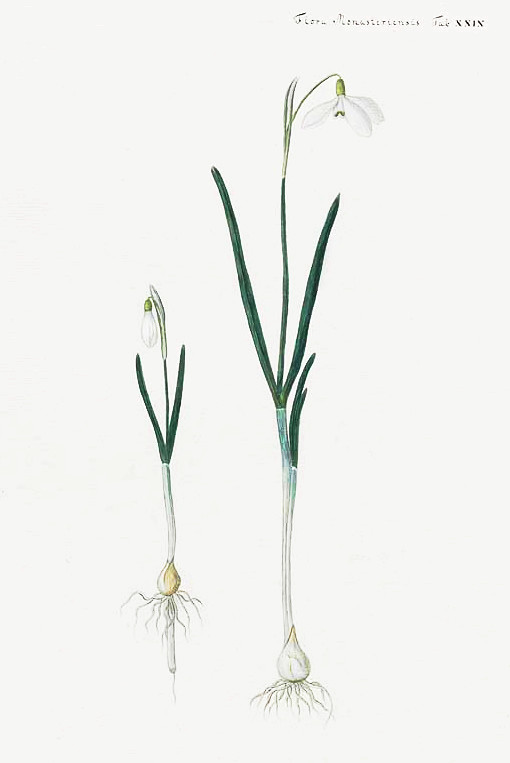Galanthus nivalis L. - syn.Galanthus imperati Bertol. - Amaryllidaceae
(common) snoedrop, (Kleines) Schneeglöckchen
Perennial herb, up to 15cm high, native to South and Central Europe, cultivated (as ornamental) and naturalized elsewhere.
„The plant and its alkaloids are very toxic and not used for self-medication… Dried and powdered bulbs of both species [G.nivalis and G.woronowii] (Galanthis bulbus) are used for alkaloid extraction… The isolated alkaloid, galanthamine, is used to alleviate the symptoms of neuromuscular ailments such as neuritis and neuralgia, as well as myasthenia gravis and polimyelitis…“
[Medicinal Plants of the World. Ben-Erik Van Wyk and Michael Wink, Pretoria 2004, 149]
Screening the family of Amaryllidaceae showed G.nivalis to contain alkaloids 0.124% (d.w.) with galanthamine 0.0031% (d.w.), and G.elwesii alkaloids 0.290% (d.w.) with galanthamine 0.0213% (d.w.).
[Kreh, Mirko. Studies on galanthamine extraction from Narcissus and other Amaryllidaceae. Taylor & Francis: London, UK, 2002, 256-272]
„Galanthamine is a long-acting, selective, reversible and competitive AChE [acetylcholinesterase] inhibitor that has recently been tested in AD [Alzheimer's disease] patients and found to be readily absorbed, to be a performance enhancer on memory tests in some patients, and to be well tolerated, although some cholinergic side effects were observed.“
[Galanthamine, a natural product for the treatment of Alzheimer's disease., Marco, L., Carreiras, M.D.C., Recent patents on CNS drug discovery, 1(1), 2006, 105-111]
„Kalashnikov (1970) also reported six alkaloids for G. nivalis L. (galanthamine, nivalidine, narwedine, lycorine, hippeastrine and tazettine). The structure of magnarine, another alkaloid isolated in the 1960s from G. nivalis, is unknown.“
The alcoholic extract from fresh aerial parts and bulbs contained alkaloids like hamayne, lycorine (galanthidine), ungeremine, tazettine and ismine, as well as various derivatives of hamayne and lycorine with hydroxylated butyric acids.
[Alkaloids from Galanthus nivalis., Berkov, S., Codina, C., Viladomat, F., Bastida, J., Phytochemistry, Vol.68(13), 2007, 1791-1798]
„The populations of Galanthus differed in their alkaloid biosynthetic pathways. Thus, the alkaloid pattern of G. nivalis was dominated by compounds coming from a para-para′ oxidative coupling of O-methylnorbelladine. The predominant alkaloids in the roots of this species were found to belong to the lycorine and tazettine structural types; bulbs were dominated by tazettine, leaves by lycorine and flowers by haemanthamine type alkaloids. In contrast, the alkaloid pattern of G. elwesii was dominated mainly by compounds coming from an ortho-para′ oxidative coupling.“
[Phytochemical differentiation of Galanthus nivalis and Galanthus elwesii (Amaryllidaceae): A case study., Berkov, S., Bastida, J., Sidjimova, B., Viladomat, F., Codina, C., Biochemical Systematics and Ecology, Vol.36(8), 2008, 638-645]
„Both G. elwesii and G. nivalis have populations dominated by galanthamine-type compounds, but G. elwesii
accumulated mainly galanthamine, while G. nivalis produced its 3,4-dihydro derivative lycoramine. The biosynthetic divergence reported for sympatric G. nivalis and G. elwesii populations, namely the predominance of compounds proceding from a para-para’ oxidative coupling of O-methylnorbelladine (haemanthamine- and tazettine-type alkaloids) in G. nivalis, and alkaloids from an ortho-para oxidative coupling (lycorine and homolycorine types) in G. elwesii, has now been confirmed for other populations.“
[Alkaloid diversity in Galanthus elwesii and Galanthus nivalis., Berkov, S., Bastida, J., Sidjimova, B., Viladomat, F., Codina, C., Chemistry & biodiversity, 8(1), 2011, 115-130]

Wernekinck, F., Icones plantarum sponte nascentium in episcopatu Monasteriensi, vol.1, t.29 (1798)
http://plantgenera.org/species.php?id_species=448735
Galanthus nivalis
© Rolf Marschner (2008), http://botanische-spaziergaenge.at/viewtopic.php?f=529&t=1563